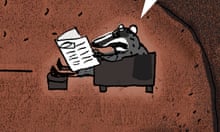Viewers were uncertain what to expect when Mad Max: Fury Road arrived in cinemas this summer. After all, it was a film that had been in development for nearly 20 years. But the fourth iteration of George Miller’s vision of a post-apocalyptic future turned out to be one of the most exciting – and thought-provoking – action movies in years. Here, the 70-year-old director talks to Paul MacInnes about the world of Mad Max (not to mention Imperator Furiosa) and the ideas that inspired it.
How did you go about creating the world of Fury Road?
So we say that this whole story starts next Wednesday, when all the things we read about in the papers come to pass at once. Then on top of that there’s stuff we never predicted, stuff that blindsided us. So the power grid goes down, and once that happens you’re losing so much of technology. All the banking is electronic, so that would go, and eventually currency is no longer important. The internet would go down and you’d lose a lot of your history. You couldn’t look at Google or Wikipedia and so on. It wouldn’t take long before you’d evolve into a more elemental state. More medieval. One of the things that triggered the second Mad Max was an oil strike in Melbourne. It’s a very sedate and ultimately easy city but it only took 10 days before the first pot shot was fired. The only petrol stations that were open were in the middle of the city and could only be used by police and ambulance drivers. People were trying to get in to the front of these very long queues and somebody pulled a gun – and we don’t even have a gun culture – didn’t fire it at anybody, fired it into the air, but I remember the moment so starkly and It really stuck in my mind.
So where does the film’s baddie, Immortan Joe, come into it?
Immortan Joe was once Colonel Joe Moore, a military man. When the coastal cities started to fall into chaos after the events of Next Wednesday, he was able to organise these hybrid military biker gangs who, when the cities were razed, migrated like locusts into the centre of the continent. There he was able to create this new dominant hierarchy in the way that tyrants have in the past, using the architecture of power to control the major resources, especially the water.
What do you mean by the architecture of power?
The great attraction of going into this world is that it’s like going forward into the past. Even though we’re 50 years ahead we go back into this more elemental time where the rules are a lot more simple and the technology is much more simple. What’s been so interesting to me has been to go to different citadels around the world – whether it’s Salzburg or any of the great forts in India or the Imperial Palace in Kyoto – and see it’s the same structure wherever you go. Essentially the structure is concentric so that those with real power reside at the very centre. That’s where the court is, where all the concubines are. In a lot of places, the actual stairways are so small and narrow and constrained that you can’t even draw a sword without bumping your head on the ceiling. I’m rambling on a bit but I just found this really interesting.
One thing that strikes is the level of craft at work in this world. Would there have been artists and craftsmen in Immortan Joe’s kingdom?
Oh yes, absolutely. One of the big things I’ve noticed in post-apocalyptic movies is that people would start with some ideas from the early Mad Maxes and paint the future as being a kind of junkyard. But if you look at all human culture, no matter how impoverished the circumstances, it doesn’t mean that there’s not a strong aesthetic. If you go back to the Paleolithic times they had very little to work with and yet they made those beautiful cave drawings which are so extraordinary. Just because it’s the wasteland doesn’t mean people have lost their ability to create beautiful things. In this world, we get about 50 years into the future and all the artefacts that survive are kind of corrupted but everything is repurposed, almost like found art. For instance, a car steering wheel now acquires the status of a religious artefact. So they put a lot of love into preserving it. Something that has survived an apocalypse would have a great importance. In this situation the people are less valuable than the artefacts.

How do you explain the guy playing the flame-throwing guitar? The Doof Warrior?
Somebody like the Doof Warrior has his own logic. There’s always the music of war – the bagpipes and the drummers and the horn players – but in this case, when you’ve got an army with hot engines, you need something very loud. So he has to have a double-necked guitar and it’s amplified and he has drummers on the back. But like everything else in the wasteland – it has to be multi-purpose – so it also has a flamethrower. Even though he’s a pretty flamboyant character, like everything else in the film, there’s a logic to him.
The real star of the film was Charlize Theron’s Imperator Furiosa. Can you talk us through her backstory?
The whole story started with a simple idea. An idea pops in your head and you push it away – because the last thing I wanted to do was another Mad Max movie – but then it festers in the back of your mind. The central concept was a) one extended chase where you had to pick up the context, the story and the characters on the run; and b) that the so-called McGuffin was to be human. What the protagonists were in conflict over was human, the five wives who were basically the property of Immortan Joe and are now on the run from him. They needed a road warrior to escort the wives, it couldn’t be a male because that’s a different story, the man stealing five wives of a tyrant. She had to be female, she had to be an experienced road warrior. Of course with that simple idea the rest came organically. The feminist notions of the film simply came out of the character and her behaviour.

We leave the film with her in charge of the citadel; you think she would be a different kind of ruler to Immortan Joe?
That’s the big question! I have to assume she would be, but we really don’t know. Allegorical stories like this are always in the eye of the beholder and in my mind i think she would have given it a much better shot than Immortan Joe. But, just as Joseph Campbell poiinted out in [seminal screenwriting bible] A Hero With A Thousand Faces, today’s hero is tomorrow’s tyrant. Meaning the hero, being the agent of change, becomes what can be called “hold fast”, ie they cling to what they’ve created. The boon they’ve bestowed on their world – they love it so much that they lose their flexibility, they lose their adaptability. We’ve seen that so often in corporations, in all sorts of institutions – never mind nations – that people will hold on to what they’ve built. Yesterday’s revolutionary becomes tomorrow’s tyrant. It’s a very common story. So, part of me thinks that she would make a much better fist of it, another part thinks that if things went horribly wrong she’d have to be a bit of a tyrant herself.
My final question: is it possible for the citadel to communicate with the rest of the world?
You mean if this story should go on in time? Wow, that’s a question. OK, here’s how I think of the world. No one is sure if there’s anyone left out there, but I just imagine that the way we are as human beings, when you look at our anthropology, we would find other worlds and connect with them. I think that’s one of the fundamental aspects of humankind. If you look at the totality of the human adventure, the great explorers of the past coming across indigenous cultures that would never have been expected to be there and indeed we’re doing the same thing with the journey to go beyond our galaxy. I think it’s just a natural instinct. Part of who we are. So once again my answer would be: I would hope so.
Mad Max: Fury Road is out now on Blu-Ray and DVD








Comments (…)
Sign in or create your Guardian account to join the discussion